Hedhvick Hirav
Hedhvick Hirav is a dedicated EV researcher and editor with over 4 years of experience in India’s growing electric vehicle ecosystem. Their contributions have been recognized in leading sustainability publications and automotive journals.
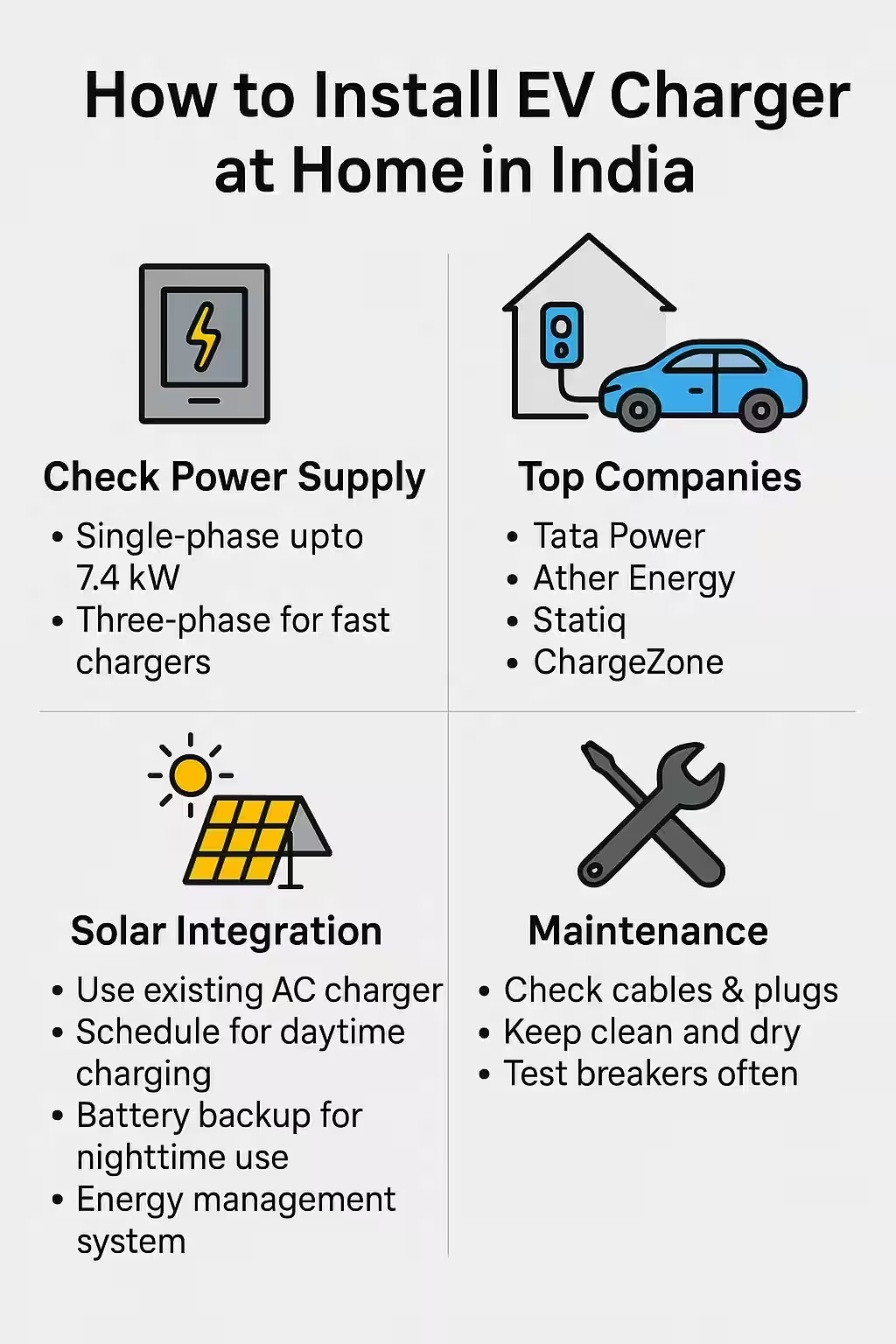
What is the Process to Install an EV Charger at Home in India in 2025?
Thinking about buying an electric vehicle (EV) or already own one? One of the first things you’ll want to figure out is how to conveniently and safely charge your EV at home. In 2025, installing a home EV charger in India has become easier, more affordable, and offers more choices than ever before. Here’s what you need to know about the process:
- Assess Your Power Supply: First, check your home’s electricity connection. Most Indian homes run on a single-phase supply, which is suitable for basic Level 1 and many Level 2 chargers. If you want a faster charger, a three-phase connection may be required.
- Choose the Right Charger: Select a charger compatible with your EV (Type 2 or CCS2 are common in India for cars; some scooters use different standards).
- Hire a Licensed Electrician: Always use a certified professional to ensure safe and compliant installation.
- Get Approvals if Needed: Some housing societies and local authorities require permissions before installation.
- Install the Charger: The installer will fix the unit, connect it safely, test it, and show you how to use it.
- Register With Discom (if needed): In some states, registering your charger with the local electricity board can help you get special EV tariffs.
Did You Know?
As per the Ministry of Power’s 2025 notification, you don’t need special permits to install a home charger, but safety and standard compliance are mandatory.
Why Should You Install an EV Charger at Home in India?
If you’re still on the fence about home EV charging, here’s why it’s quickly becoming essential, especially in Indian cities and suburbs:
-
Convenience: Charge anytime—overnight or during the day, without waiting in queues at public stations.
-
Cost Savings: Home charging is cheaper than public fast charging stations. Many states offer discounted EV tariffs for home users from 2025.
-
Peace of Mind: Always start your day with a full charge, no worries about range anxiety.
-
Property Value: Adds to your home’s resale appeal, especially in metropolitan cities.
-
Environmental Benefits: You can combine with solar panels to make charging even greener.
-
According to a 2025 report by NITI Aayog, 78% of new EV buyers in urban areas prefer home charging due to cost and convenience.
Expert Insight
Indian cities like Bengaluru and Pune have reported a 60% rise in home EV charger installations in 2024-2025, showing that personal charging is the new norm.
When Is the Best Time to Install a Home EV Charger in India?
Timing your installation can make a difference in cost and convenience. Here’s what to consider:
-
When Buying a New EV: The best time is just before or soon after you take delivery of your car or scooter.
-
During Home Renovation: If you’re already doing electrical work, it’s easy to add the wiring for a charger.
-
Before the Summer Surge: Power demand rises in summer. Installing during off-peak seasons can mean quicker service.
-
When Tariff Offers Launch: Watch for state discom schemes, often launched in April or October, for discounted rates or rebates.
-
In 2025, several DISCOMs (like TANGEDCO and MSEDCL) offer reduced installation fees during the financial year start.
Did You Know?
Tata Power and Fortum India both offer festive discounts and bundled installation packages around Diwali and Independence Day.
Which Types of Home EV Chargers Are Available in India for 2025?
It’s no longer just “plug and charge”. You now have multiple options, each with their own pros and cons:
- Level 1 Charger (Slow): Uses a standard 15A wall socket; adds 5-10 km range per hour.
- Level 2 Charger (AC Fast): Dedicated equipment, 3.3 kW to 7.4 kW output; adds 15-40 km per hour. Most popular in India.
- Level 3 Charger (DC Fast Home): Rare for homes due to high cost and power needs; mainly for commercial or luxury EVs.
- Smart Chargers: Wi-Fi or Bluetooth enabled, app-controlled, scheduling, load balancing.
- Solar-integrated Chargers: Connects with your rooftop solar to charge directly using green energy.
Home EV Charger Comparison (2025)
| Charger Type | Power Output | Charge Time (0-100%) | Cost (INR) | Install Complexity | Best For |
|---|---|---|---|---|---|
| Level 1 (15A plug) | 2.2 kW | 12-18 hours | 2,500-4,000 | Easy | Daily city driving, scooters |
| Level 2 (AC) | 3.3-7.4 kW | 5-8 hours | 25,000-70,000 | Moderate | All personal EV cars |
| DC Fast Charger | 15-30 kW | 1-3 hours | 3-6 lakh | Complex | Fleet, high-end users, luxury |
| Smart Charger | 3.3-22 kW | 3-8 hours | 50,000-1 lakh | Moderate | Tech-savvy, energy management |
| Solar-integrated | Up to 7.4kW | 5-8 hours | 60,000-1.5 lakh | Complex | Eco-conscious, solar rooftops |
- Level 2 chargers are the sweet spot for most Indian homes in 2025.
- Smart chargers allow you to schedule charging when rates are lowest.
- Solar integration can reduce your charging cost to zero after ROI.
Expert Insight
The government’s FAME-II scheme in 2025 does not directly subsidize home chargers but encourages DISCOMs to provide affordable tariffs for residential users.
Which Are the Top 10 Home EV Charger Companies in India for 2025?
With over a dozen reliable brands, Indian users have more choice than ever. Here are the biggest names, with what sets them apart:
| Company | Model(s) | Power Range | Price (INR) | Smart Features | Warranty | Installation Support | Best For |
|---|---|---|---|---|---|---|---|
| Tata Power EZ | EZ Home, EZ Fast | 3.3–7.4 kW | 29k–79k | App, remote | 2 yrs | Yes | Tata, MG, Nexon owners |
| Ather Grid | HomePod | 3.3 kW | 25k–40k | Yes | 2 yrs | Yes | Scooters, city users |
| Exicom | Harmony | 3.3–7.2 kW | 30k–68k | Yes | 2 yrs | Yes | Multi-brand compatibility |
| ABB India | Terra AC Wallbox | 7.4–22 kW | 60k–1.2L | Advanced | 2 yrs | Yes | High-end, smart homes |
| Delta | AC Mini Plus | 3.3–7.4 kW | 28k–73k | Yes | 2 yrs | Yes | Fast, value-for-money |
| Fortum India | HomePlug | 3.3–11 kW | 32k–85k | Yes | 2 yrs | Yes | Reliable service, app control |
| Magenta ChargeGrid | ChargeGrid Home | 3.3–7.4 kW | 26k–62k | Smart | 2 yrs | Yes | Affordable, Indian make |
| Servotech | EV AC Charger | 3.3–11 kW | 29k–82k | Basic smart | 1 yr | Yes | Quick install, budget |
| Pulse Energy | Home Charge Pro | 3.3–7.4 kW | 29k–65k | App | 2 yrs | Yes | Custom installs, new users |
| Okaya | EV AC Charger | 3.3–7.4 kW | 25k–76k | Yes | 2 yrs | Yes | Widely available, robust |
Brand Summaries
- Tata Power EZ: India’s largest EV charger installer, with fast service and wide compatibility.
- Ather Grid HomePod: Designed for 2-wheelers and city cars, compact and affordable.
- Exicom Harmony: Versatile, works with most EVs, good after-sales support.
- ABB India: Global leader, advanced smart features, best for high-end residences.
- Delta: Reliable, energy-efficient, and value for money.
- Fortum India: European tech, great app interface, expanding rapidly in metros.
- Magenta ChargeGrid: Made in India, affordable, quick customer service.
- Servotech: Budget solution, decent reliability for non-premium users.
- Pulse Energy: Good for custom installations, rising startup.
- Okaya: Sturdy chargers, wide dealer network, good for Tier-2/3 cities.
Did You Know?
Tata Power has crossed 60,000+ home charger installations across India as of March 2025.
How Much Does It Cost to Install an EV Charger at Home in India (2025)?
Cost is a major factor for any Indian homeowner. Here’s the complete breakdown for 2025:
- Basic Wall Socket (15A): ₹2,500–₹4,000 (just the socket, not recommended for long-term use)
- Level 2 Charger (3.3–7.4 kW): ₹25,000–₹80,000 (charger unit only)
- Smart/Connected Chargers: ₹50,000–₹1,00,000
- Professional Installation: ₹2,500–₹10,000 (depends on wiring, distance, and mounting)
- Upgrading Power Supply: ₹8,000–₹20,000 (for three-phase, if required)
- Solar Integration: ₹40,000–₹1,20,000 extra (for inverter, connection, etc.)
Typical total cost:
- For a standard Level 2 charger (including installation): ₹35,000–₹90,000
- With solar integration: ₹1,00,000–₹2,00,000 (including solar inverter and wiring)
Home EV Charger Cost Comparison (2025)
| Component | Low-End (INR) | High-End (INR) | Notes |
|---|---|---|---|
| Charger Unit | 25,000 | 1,00,000 | Depends on brand/features |
| Installation | 2,500 | 10,000 | Higher if wiring is complex |
| Power Upgrade | 8,000 | 20,000 | Only if needed |
| Solar Integration | 40,000 | 1,20,000 | Inverter/panel extra |
| Total (no solar) | 35,500 | 1,30,000 | Standard setup |
| Total (with solar) | 1,00,000 | 2,20,000 | Includes solar hardware |
Expert Insight
Delhi, Maharashtra, and Karnataka offer the lowest installation costs due to bulk government partnerships with charger manufacturers in 2025.
How to Integrate Solar Power with Your Home EV Charger in India?
Adding solar to your home EV charger is the ultimate green move in 2025. Here’s how you can do it:
- Check Rooftop Feasibility: Make sure your terrace or roof gets enough sunlight (ideally, south-facing).
- Choose Compatible Charger: Some brands (like Delta, ABB, Magenta) offer solar-ready chargers with special inverters.
- Install Solar Panels: Work with government-approved solar vendors; average homes need a 2–3 kW panel setup for daily EV charging.
- Connect with Solar Inverter: The inverter directs solar power to your home and charger.
- Register for Net Metering: This lets you sell excess power back to the grid, further reducing your bills.
Steps to Set Up Solar EV Charging
-
Get a solar site assessment from a certified installer.
-
Choose a charger with solar integration.
-
Apply for net metering with your state DISCOM (most states automate this in 2025).
-
Install panels, inverter, and charger together for seamless operation.
-
Disclaimer:
Solar integration costs more upfront. ROI is typically 5–7 years for an average Indian home, but ongoing costs are almost nil.
Did You Know?
In 2025, Indian states like Gujarat and Rajasthan provide 40% subsidy on residential solar panel installation, making solar EV charging highly affordable.
What Are the Government Policies and Subsidies for Home EV Charger Installation in India (2025)?
Stay updated with the latest rules and incentives for home charging in 2025:
- No Special Permit Needed: You can install a private charger without special permission, as per Ministry of Power, March 2025.
- EV Tariff: Most states (Delhi, Maharashtra, Tamil Nadu) offer reduced electricity rates for EV charging at home.
- Solar Subsidy: Central government and select states offer up to 40% subsidy for rooftop solar installations (including EV integration).
- Net Metering: Most metro cities now have simple, online net metering registration.
- Local Policies: Some cities (Bengaluru, Hyderabad) offer additional rebates on charger installation during special drives.
| Policy/Incentive | Applicability | Details (2025) |
|---|---|---|
| FAME-II (direct) | Home chargers | Not applicable |
| State EV Tariff | Delhi, Maharashtra, TN, others | 4.5–6.5 Rs/unit |
| Solar Subsidy | PAN India + 8 states | 20–40% on panel cost |
| Net Metering | Most urban states | Yes, easy online process |
| Local Rebate | Mumbai, Bengaluru, Chennai | Up to 5,000 off install |
Expert Insight
Check your city’s EV cell website for the latest state-specific offers as they change every budget season.
How Do You Maintain Your Home EV Charger in India?
Home chargers are low-maintenance, but a few basic habits can extend their life and reduce risks:
-
Regular Cleaning: Keep the charger dust-free and protected from rain if outdoors.
-
Check Cables: Inspect for wear/tear or loose connections every few months.
-
Software Updates: Many smart chargers need app or firmware updates for security.
-
Annual Inspection: Get a licensed electrician to inspect the setup once a year.
-
Surge Protection: Install a surge protector, especially in areas prone to power cuts or lightning.
-
Most major brands offer 2-year on-site warranty and extended AMC (Annual Maintenance Contract) plans for peace of mind.
Did You Know?
In 2025, 95% of charger malfunctions in Indian metros are due to improper installation or lack of surge protection—not manufacturing defects.
How Safe Is It to Install and Use an EV Charger at Home in India?
Safety is top priority, especially with the Indian monsoon and variable power conditions. Here’s what you need to know:
-
Always Use Certified Installers: Never DIY unless you’re an expert.
-
Proper Earthing: Absolutely essential; prevents shocks and device failures.
-
Waterproof Enclosure: Use IP65-rated boxes if installed outdoors.
-
Dedicated Circuit: Don’t share the EV charger’s circuit with other heavy appliances.
-
Child Lock Feature: Many smart chargers now have this to prevent accidental use.
-
Indian BIS certification is a must for all new home chargers sold in 2025.
-
According to a 2025 study by CEEW, professionally installed chargers have a <0.1% incident rate in Indian homes.
Expert Insight
Avoid charging from basic wall sockets for prolonged periods as it can overheat Indian household wiring, especially during summer months.
How Long Does It Take to Charge an EV at Home in India?
Charging speed depends on your charger’s power, your vehicle’s battery size, and your home’s electrical setup. Here’s the 2025 scenario:
-
Two-wheelers (Ather, Ola, TVS):
- 15A Plug: 3–5 hours
- Level 2 Charger: 1.5–3 hours
-
Cars (Tata Nexon EV, MG ZS, BYD Atto 3, Hyundai Kona):
- 15A Plug: 12–18 hours (full charge)
- Level 2 Charger (3.3kW): 6–9 hours
- Level 2 (7.4kW): 3–5 hours
-
Premium EVs (BYD Seal, Kia EV6, Volvo XC40):
- Level 2 (7.4–11kW): 4–7 hours
- DC Home Charger (very rare): 1–3 hours
| EV Model | Battery Size | 15A Plug (hrs) | 3.3kW (hrs) | 7.4kW (hrs) |
|---|---|---|---|---|
| Tata Nexon EV | 40 kWh | 16 | 8 | 4 |
| MG ZS EV | 50 kWh | 18 | 10 | 5 |
| Ather 450X | 3.7 kWh | 4 | 2 | – |
| Ola S1 Pro | 4 kWh | 5 | 2.5 | – |
| Hyundai Kona | 39 kWh | 16 | 8 | 4 |
| BYD Atto 3 | 60 kWh | 20 | 12 | 6 |
- For most Indian users, overnight charging (7–8 hours) is sufficient for daily commutes.
Did You Know?
In 2025, nearly every EV sold in India comes with a free portable charger for emergencies—but dedicated home chargers are far more efficient and safe.
What Are the Real Users’ Experiences of Installing EV Chargers at Home in India?
Here are some first-hand stories and case studies from Indian users in 2025:
Arjun, Mumbai (Tata Nexon EV, Residential Society):
- Installed Tata Power EZ Home 7.4kW charger.
- Society permission was smooth after showing product safety certification.
- Cost: ₹42,000 (including installation).
- Uses solar integration, net metering saves ₹1,500/month on bills.
Priya, Bengaluru (Ather 450X, Apartment):
- Chose Ather HomePod due to compact size.
- Installation in parking bay, coordinated with electrician and society maintenance.
- Total cost: ₹29,000.
- Charges overnight, no issues in 10 months.
Rahul, Chennai (Hyundai Kona, Independent House):
-
Went for Delta AC Mini Plus with 3.3kW output.
-
Three-phase upgrade was needed, extra ₹14,000.
-
Installation done in 3 days, uses mobile app for scheduling.
-
Happy with after-sales support.
-
Tip from users: Always check society by-laws and get a written NOC before installation to avoid disputes.
Expert Insight
Over 60% of Indian EV users in 2025 report positive experiences with home charging, mainly due to hassle-free daily use and lower running costs.
How to Choose the Best Home EV Charger for Your Needs in India?
With so many brands and features, use these criteria to make an informed choice:
- Vehicle Compatibility: Always match the charger type (plug, connector) to your EV.
- Charging Speed: Balance your daily driving needs with your home’s power supply.
- Smart Features: Useful for scheduling, tracking power usage, and remote control.
- Warranty & Service: Look for at least a 2-year warranty and local service support.
- Installation Support: Opt for brands that offer end-to-end installation.
- Budget: Consider total cost of ownership, not just upfront price.
- Upgrade Options: If you plan to buy another EV, consider a higher-rated charger.
Best for… (2025)
- Budget/Entry Level: Magenta ChargeGrid, Okaya
- Smart Features: ABB, Fortum
- Solar Integration: Delta, Tata Power, Exicom
- 2-Wheelers: Ather Grid HomePod, Servotech
- Fast Charging: ABB, Tata Power EZ Fast
Did You Know?
Many Indian charger brands now offer EMI options and buy-back schemes for 2025, making upgrades easier.
Conclusion: Should You Install an EV Charger at Home in India in 2025?
By now, you can see that installing a home EV charger in India has never been easier, safer, or more affordable. With top brands, government incentives, and solar integration options available, you can choose a setup that perfectly fits your budget and lifestyle. Most users find daily charging at home not only cheaper but also more convenient and future-proof.
Your Next Steps:
- Check your home’s electrical supply and compatibility
- Shortlist charger brands based on your vehicle and budget
- Contact certified installers or your EV dealer for the best deals
- Consider adding solar for ongoing savings
- Always follow safety norms and local permissions
Investing in a home EV charger is one of the smartest moves you can make as an EV owner in India in 2025—providing convenience, savings, and peace of mind for years to come.
FAQs
Q1: Is it compulsory to get government approval to install a home EV charger in India (2025)?
No, as per the latest 2025 government rules, private EV chargers at home do not require special approval, though you should follow safety norms and get society NOC if in an apartment.
Q2: Can I use my regular home socket to charge an EV long-term?
While possible, it is not recommended due to slower charging and higher risk of overheating. Dedicated Level 2 chargers are safer and more efficient.
Q3: What is the typical payback period if I install solar for my home EV charger?
With 2025 subsidies, most users recover their costs in 5–7 years through reduced electricity bills and net metering benefits.
Q4: Will installing an EV charger increase my electricity bill significantly?
You’ll see an increase, but charging at home is still much cheaper than petrol/diesel costs. With EV tariffs, per-km cost is usually below ₹2/km for most cars.
Q5: Can I move my home EV charger if I shift houses?
Yes, most wall-mounted chargers can be professionally removed and reinstalled at a new location, though you’ll need fresh installation and wiring at the new spot.
Disclaimer: All prices, offers, and policies are as per verified public and manufacturer data available until June 2025. Always check with local authorities and service providers for the most current information.


